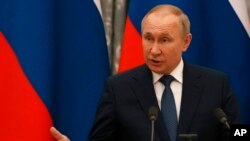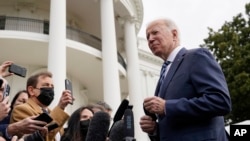Germany on Tuesday halted the Nord Stream 2 Baltic Sea natural gas pipeline project designed to double the flow of Russian gas to Germany, a day after Moscow formally recognized the Russian-occupied regions of Donetsk and Luhansk in eastern Ukraine as independent states.
What is Nord Stream 2?
The more than $11 billion project that has bothered Germany’s allies was completed in September but has been idle pending certification by Germany and the European Union.
Nord Stream 2 was halted as it was set to ease pressure on European consumers facing soaring energy prices and governments that have spent billions of dollars to limit the impact on their citizens.
The 1,200-kilometer underwater Nord Stream 2 follows the same path as Nord Stream 1, which was finished more than a decade ago.
Like Nord Stream 1, the idle pipeline is capable of transporting 55 billion cubic meters of gas per year from Russia to elsewhere in Europe, potentially boosting the continent’s access to relatively low-priced gas when domestic production is declining.
Why did Germany support Nord Stream 2?
Germany, which gets half its gas from Russia, maintained the pipeline was mainly a commercial project to diversify energy supplies for Europe.
Germany aggressively pursued the pipeline for years, working through the poisoning of Kremlin critic Alexei Navalny, several spying scandals and multiple cyberattacks.
Even as some 150,000 Russian troops steadily assembled on Ukraine’s borders, German Chancellor Olaf Scholz did not mention the name of the pipeline when asked about possible sanctions against Russia.
Why is Germany taking action now?
On Tuesday, Russian President Vladimir Putin decided to recognize the Russian-occupied regions of Donetsk and Luhansk as independent. Hours later, German Chancellor Olaf Scholz said he had requested a halt to the pipeline approval process, despite record high gas prices in Europe.
Scholtz said Russia’s decision to recognize the independence of the rebel-held areas was a “serious break of international law” and that it was necessary to “send a clear signal to Moscow that such actions won’t remain without consequences.”
Scholz, who succeeded Angela Merkel in December, also said he withdrew a report that Germany was required to submit on how the pipeline would affect energy security.
Why does Russia want the pipeline?
The Russian state-owned gas company Gazprom, which owns half of Nord Stream 2, said the pipeline would meet Europe’s needs for relatively affordable gas and supplement existing pipelines in Ukraine and Belarus.
Gazprom said Nord Stream 2 would offer an alternative to Ukraine’s aging pipeline that it says needs refurbishment. The gas giant also said the new pipeline would lower costs by saving transit fees paid to Ukraine and avoid gas cutoffs like those that occurred briefly in 2006 and 2009 due to Russia-Ukraine disputes over prices and payments.
Europe is in growing need of gas because it is replacing decommissioned coal and nuclear plants before the energy they produce can be replaced by renewable sources such as wind and solar.
Why do the United States and most other Western allies oppose Nord Stream 2?
The European Union and the United States argued that Nord Stream 2 would increase Europe's energy dependence on Russia and deny transit fees to Ukraine, host to a separate Russian gas pipeline, and make Ukraine more vulnerable to Russian invasion amid Europe’s worst crisis since the Cold War.
They also contend the pipeline would give Russia the possibility of using gas as a geopolitical weapon, as Europe imports most of its gas, 40% of which comes from Russia.
Ukraine, which has been in conflict with Russia since Moscow’s annexation of Crimea in 2014, has long opposed Nord Stream 2. The pipeline bypasses Ukraine’s infrastructure, depriving it of more than $1 billion annually in gas transit fees, while making Russia less dependent on cooperation with Ukraine.
U.S. President Joe Biden waived sanctions against the pipeline’s operator last year in exchange for an agreement from Germany to act against Russia if it used gas as a weapon or attacked Ukraine.
How will suspending Nord Stream 2 affect Europeans this winter?
European regulators said before Scholz’s move the approval process could not be completed in the first half of this year, meaning the pipeline was not going to help European households meet heating and electricity needs this winter.
Could Russia cut off gas to Europe in retaliation?
Many expert observers believe Russia would not cut off supplies to Europe because Gazprom also needs the European market. Russian officials have also emphasized they have no plans to do so.
Half of Nord Stream 2 is owned by the Russian state-owned gas company Gazprom and the rest is divided between the Anglo-Dutch company Shell, Austria's OMV, France's Engie, and Germany's Uniper and Wintershall.
Some information for this report came from Agence France-Presse, The Associated Press and Reuters.










